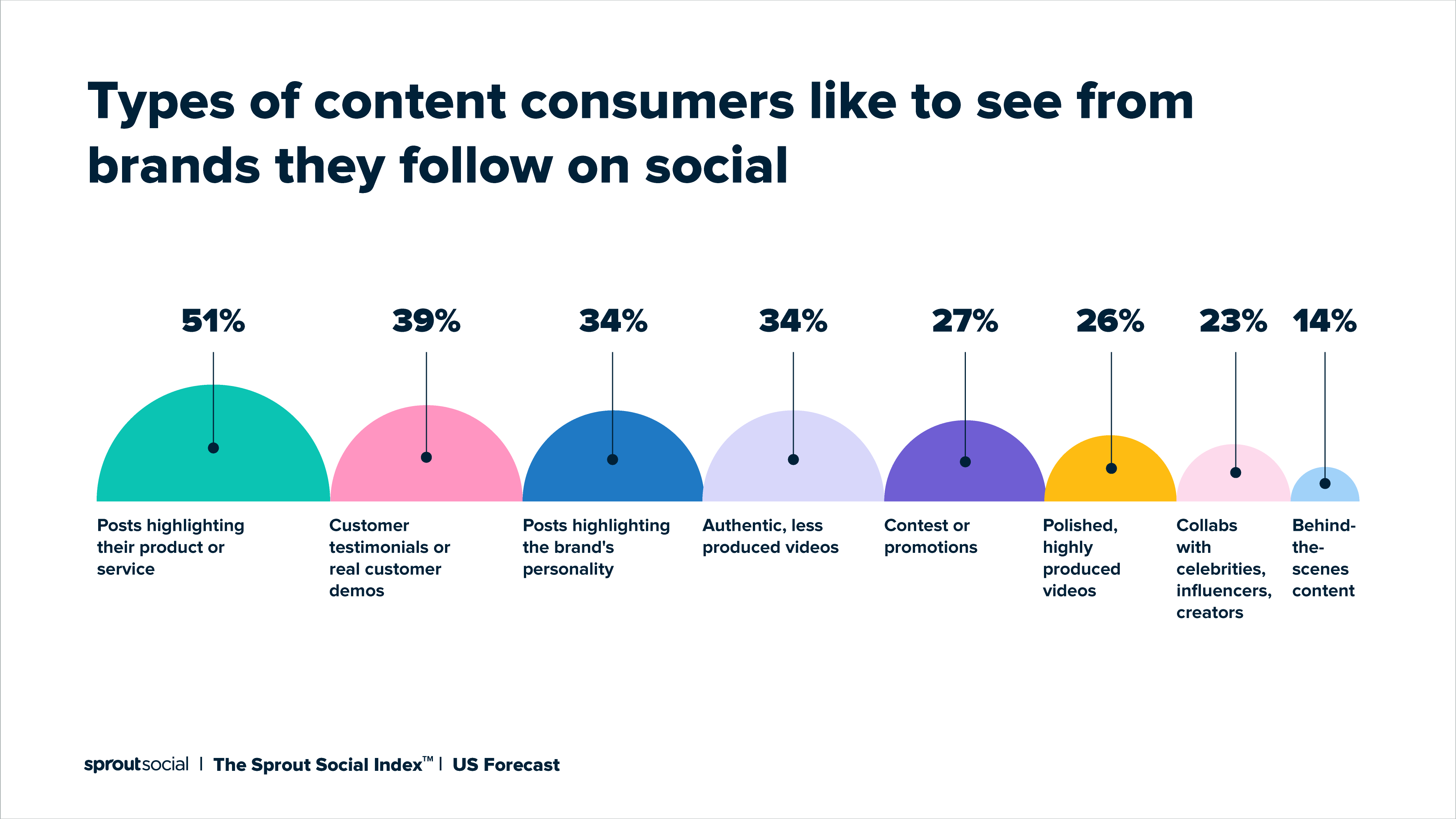Hot take: mastering social media is what sets businesses today apart.
Competition is fierce among brands and attention is scarce. Establishing an identity and sense of community via social is key to standing out.
Not to mention attracting valuable new customers.
Done right, a goal-driven social strategy means positive results for your business. Countless brands have been built from the ground up via Facebook, Instagram and TikTok.
Wrangling your social media strategy can be daunting with so many moving pieces. This is especially true if you’re totally new to the space. We get it.
That’s why we put together this post breaking down the basics of social media for business.
Table of contents
- Benefits of social media for business
- Setting social media goals for your business
- Follow these 5 social media tips for business
- Use social media marketing tools for business
- Uncover social analytics and reporting for business
- Involve your C-Suite and employees to amplify your business
- Work on a corporate communication plan
- Go beyond the basics of social media for business
Benefits of social media for business
“Okay, so why is social media important for business?”
Good question! A decade ago, the upsides of social media for business were tougher to quantify.
Thankfully, times have changed and ROI is no longer a question mark. Let’s be crystal clear:
Social media is valuable for businesses of any size or industry. Finding customers on social media has a direct impact on sales and your bottom line.
Building awareness. Nurturing leads and driving sales. Community-building.
The list goes on given that the benefits of social media aren’t one-size-fits-all. That said, here are five upsides that brands can see from a smart social presence.
Like it or not, social media has become a go-to research channel for consumers at large.
Think about your own experience looking up businesses.
Chances are you’ve visited a restaurant’s Facebook to confirm their hours. Maybe you’ve combed a company’s IG content and comments to see if their products live up to the hype. This highlights how social media builds awareness for brands in a way that your website can’t.
Your business’ social presence is a powerful touchpoint with new customers. That’s because social media serves as an authentic reflection of what a company is all about.
Comments and shout-outs from satisfied customers speak volumes about your business. If someone’s first impression of your business is a glowing social review, that’s a huge plus.

Create a meaningful connection with your customers
It’s no exaggeration to say that social media serves as a Swiss Army Knife for customer support.
For reference, many brands use their social presence to…
- Answer questions from potential customers
- Handle concerns from existing customers
- Celebrate and welcome new customers
- Gather feedback from your target audience
Channels like Facebook and Instagram are a timely alternative to email or chatbots. These channels also offer opportunities to personalize your responses and build connections. Going back and forth with your customers via comments can leave a lasting impression.

Show off your products (and what makes them compelling)
From testimonials to tutorials and beyond, social media is a prime place to show off products.
As noted in the Sprout Social Index™, the most popular types of posts teach people how products work. For example, an IG Reel or TikTok can educate a potential customer in a matter of seconds. Contrast this with static photos and traditional product descriptions.

Formats such as short-form video empower brands to bring their products to life. Bonus points if you can feature real people and satisfied customers in your content.
Increase your brand’s visibility and reach
Recent demographics show us that people are spending hours per day on social media, not just a few minutes here and there.
This highlights the value of businesses having an established social presence. Many potential customers will see your brand’s Facebook or IG before they see your website.
Look no further than the rise of social search as evidence of this. Trends and research say that young consumers treat social media like a search engine.

The more word of mouth your business earns, the easier it is for your audience to find you. This applies to social searchers and potential customers alike.
Gather real-time insights to make data-driven business decisions
Social media marketing for business is about so much more than promotion.
Consider how you can use analytics to research the following in real-time:
- Audience pain points
- Competitor messaging and content
- Sentiment analysis (and how people feel about your brand)
- The most popular types of products and content among your follow
- The latest trends in your industry
And that only scratches the surface!
From your audience to competitors, there’s no better place to conduct market research. That’s because social media is a treasure trove of data points that are all out in the open.
Setting social media goals for your business
The benefits of using social media for business speak for themselves.
That said, achieving them doesn’t happen by accident. That’s why goal-setting is so important.
Keep in mind that social media goals> are unique as they’re totally dependent on your business. Also, you can set multiple goals that actually overlap and influence each other. Goals affect everything from your content strategy to the social platforms you use.
Setting social media goals for business
There’s no “right” way to set goals but the process can be a lot. A few tips to get you started:
- Start with the big picture before getting granular. Why does your business need a social presence? What resources do you need to make those results a reality?
- Look at your target audience and customer personas. For example, how are your customers using social media? Is your audience glued to TikTok or Instagram? What types of content do they want to see? Brainstorm how using social media for business can help you reach your audience.
- Think about your business’ holistic marketing strategy and how social media fits in.
- Tie your social media goals to actual metrics and KPIs. This is a big one in an era where marketers are under pressure to prove ROI. From engagement to traffic and beyond, there’s plenty to track.
Sample B2B social media goals and KPIs
- Brand awareness (growth, engagements) and consideration (link clicks, web traffic)
- Lead generation (marketing qualified leads)
- Competitor analysis (share of voice) and market share
- Audience engagement (likes, replies, shares, etc.)
- Drive customer loyalty (+ CX) and reduce churn
- Customer service efficiencies (engagement speed and rates)
- Reputation management
- Customer satisfaction
- Positive reviews
- Customer sentiment online
Sample B2C social media goals and KPIs
- Brand awareness (growth, engagements) and consideration (link clicks, web traffic)
- Find new sales opportunities (conversations to join)
- Uncover brand expansion opportunities
- Reputation management (engaging with inbound messages)
- Increase customer satisfaction
- Inspire customer loyalty
- Product launch analysis
- Competitive analysis
Create a social media strategy for business
Let’s say you have your goals squared away.
Remember: effectively using social media for business means having a plan. Posting at random won’t do you any favors. Without a strategy, your social presence can quickly become a time-sink.
No pressure, right? Mapping your social media marketing strategy doesn’t have to be daunting. To keep your focus and avoid getting overwhelmed, here’s what we suggest you focus on:
- Ensure social goals solve challenges
- Extend social marketing efforts throughout your organization
- Focus on networks that add value
- Create engaging content
- Identify business opportunities through social
- Engage instead of ignore
- Track, improve and market your effort
If you focus on these points, you’ll already be way ahead of the curve.
Follow these 5 social media tips for business
There’s no shortage of social media tips out there to help you fine-tune your strategy.
Some best practices related to social media for business are relative. Below are five universal tips that are fair game for companies of all shapes and sizes.
1. Build a human, people-first social presence
This might seem like a no-brainer.
That said, busy businesses tend to get stuck in a “copy-and-paste” approach to social. Comments and social captions should feel like they were written by a real person, not a robot.
Injecting personality into your posts is a low-hanging way to relate to your audience. Beyond that, personalizing your replies to people shows that you’re there to help them. This is an example of how to use social media for business to build connections.

2. Look at your social presence as a resource (not just a promotional channel)
Don’t make the mistake of treating your social presence as a dumping ground for offers. Building an audience means being genuinely helpful, not salesy.
Many of the best practices across social media treat their accounts as resources. That means:
- Creating actionable, educational content (think: how-tos, tutorial videos)
- Answering questions and sharing advice with your audience
- Sharing company updates and keeping customers in the loop (see below)
Imagine that your social accounts are your first touchpoint with a potential customer. Sharing resources makes a better first impression than screaming “BUY NOW!”
3. Show up consistently
This applies to both publishing content and engaging with customers.
Conventional wisdom says that social media algorithms reward consistency. Sprout’s own research on the best times to post on social media confirms this. If nothing else, letting your social feeds gather cobwebs isn’t a good look.
Neither is leaving your followers hanging. Making a conscious effort to reply to questions and comments is crucial. This is why you need to keep a close eye on your @tags and social notifications.

4. Be prepared to experiment with different types of content
Brands are spoiled for choice when it comes to the types of content they can post.
Below are two examples of brands with diverse social feeds in terms of content.

From short-form videos to Stories and slideshows, you have plenty of options. Different industries and types of brands thrive on different types of content.
That said, don’t make assumptions when it comes to what performs best.
Just because a competitor posts a bunch of memes doesn’t mean you should follow suit. Let your own analytics and engagement guide your content strategy.
5. Don’t treat your social presence like an island
Social media shouldn’t be a siloed channel separate from the rest of your marketing efforts.
From announcements to offers and company initiatives, social can be in the middle of it all. For example, a feature rollout isn’t something a SaaS brand should restrict to its email list. These sorts of updates should be front and center on social, too.

A more holistic approach to social media marketing for business is ideal. In turn, you maximize your marketing assets elsewhere and see a greater ROI for your efforts.
Use social media marketing tools for businesses
Good news: you’re not expected to do everything totally DIY when building your presence.
There’s no shortage of social media marketing tools out there to help with the heavy lifting. Depending on your needs, you might consider investing in a combo of the following:
- Scheduling tools that allow you to queue up content across multiple platforms
- Analytics tools that measure content performance and engagement (see Sprout Social below)
- Listening and monitoring tools that make it easier to track audience conversations

Remember: the purpose of these tools should be to make you more productive. A big challenge in building any sort of marketing stack is redundancies. It’s easy to invest in tools that overlap. This results in brands burning through their budgets and needlessly bouncing between platforms.
Uncover social analytics and reporting for business
The more opportunities to consolidate your tools, the better. Working with fewer tools means squeezing the most out of what you have. Also, you save a ton of time onboarding.
The less bouncing between tools, the better. This speaks to the value of an all-in-one social media management platform like Sprout.
With Sprout, brands access a comprehensive suite of social tools and analytics. For example, the platform makes it a cinch to map out your content calendar across platforms. This is a shining example of how to save time and avoid bouncing between tools.

Sprout’s analytics and dashboards encourage a goal-driven approach to social media for business. Advanced analytics means fewer question marks and a better understanding of your presence. This includes your top-performing content and social channels.

In short, you have a constant pulse on what’s working, what’s not and what you should do next.
Involve your C-Suite and employees to amplify your business
As noted earlier, social media shouldn’t be treated as an island.
This applies to your own team as well. The sooner you’re able to get approval and buy-in from your C-Suite, the better. Brand-building through employee advocacy is another way to use social media for business.
Employee advocacy is the promotion of a brand by its employees on social media. Instead of solely promoting products, advocates promote a company at large. This means:
- Sharing behind-the-scenes experiences about work life
- Celebrating team members and workplace accomplishments
- Amplify company messages and promotions
Chances are you’ve seen your fair share of employee advocacy in action on LinkedIn.
Again, the crowded nature of social media means anything you can do to stand out is a plus. Advocacy is an opportunity to boost your company’s profile and exposure via social.
Work on a corporate communication plan
One last pointer for anyone on the enterprise level.
The power of social media as a communication channel shouldn’t be taken lightly. Brands have the opportunity to reach massive audiences at a moment’s notice. This applies to customers, industry leaders and competitors alike.
The stakes are high for large companies with significant audiences and stakeholders. That’s why having a corporate communication plan is crucial. In short, you need to establish rules for:
- Internal communication, including employee engagement and internal marketing
- External communication, including PR and how you speak to the public
- Executive communication (ex: how the C-level discusses your company on social media)
- Crisis communication to deal with controversies and damage control situations
Having all of the above squared away empowers brands to have consistent messaging. Likewise, you can avoid miscommunication and countless public headaches in the process.
Going beyond the basics of social media for business
An active social presence is an expectation, not an exception for companies today.
The tips and best practices above serve as a solid foundation. With the right goals and mentality, social media can have a positive impact on your business.
Building a results-driven social media presence is so much easier with a platform like Sprout. From content to trend analysis and beyond, Sprout empowers brands to build their presence with confidence. If you haven’t already, test-drive a free trial of Sprout Social to see the full suite in action for yourself!
The post The complete guide to social media for businesses appeared first on Sprout Social.